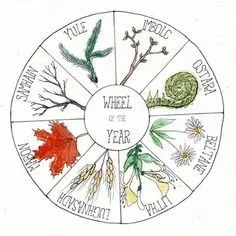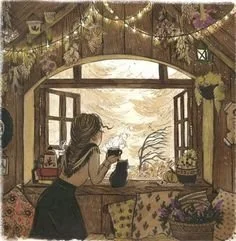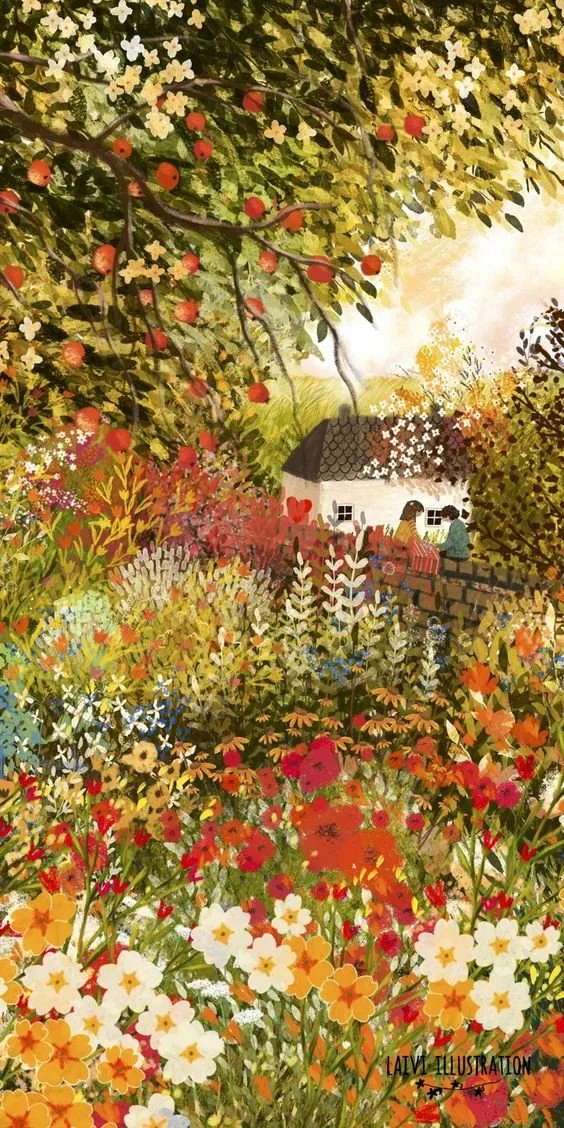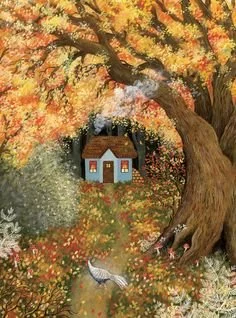Seasonal Awareness in the Home and the HearthKeeper
“Christians can find many useful and edifying things in non-Christian myths and, because of their insight into the truth of God, can in fact ponder such myths more deeply.” Tolkien Dogmatics by Austin Freeman
This article is an Abby/Sarah compilation. I took Sarah's notes from a particular book and turned them into a full-blown article. I won’t cite the book since I can’t recommend it even with heavy caveats. If you are interested in a broader discussion of this topic…or maybe a more wibbly-wobbly discussion, check out our podcast Episode 1.4: Seasons.
The Agricultural Wheel is a modern amalgamation of traditional holidays held by ancient Germanic and Celtic peoples, and represents the natural cycle of birth, life, death, and rebirth found in the natural order of God’s creation.
This calendar can be a helpful tool for the homemaker. It can help us instill constant diversity in our homes—preventing stress and stagnation—and help us be prepared for the next season’s needs before they’re here. There’s nothing worse than the cold and flu season arriving without medicines, tinctures, and infusions in our cabinets. The homemaker should always strive to be prepared for what’s coming and not stagnate.
So, how does the Agricultural Wheel work?
The calendar is divided into different sections, as the spokes of a wheel. You have the Equinoxes which are days of seasonal change where the night and day are in balance. You have the Solstices which are days of seasonal change where the day is either the shortest or longest. These are celebration and feast days, but also days of rest and reflection. The cross-quarter days fall in the middle of the season as a reminder to look backward and forward, to prepare for what is next, and that change is coming. These are review days.
The Winter Solstice/Yule: (First day of Winter, typically December 21) This is the shortest day of the year, but from here the light begins to return. This is a time of celebration and newness. This is a time for the homemaker to rest and reflect. What a delight to have this day a few days before Christmas! We see the darkness, but we know the light is returning. Some things you can include in your home to create a cozy vibe are all the things that make us love the Christmas holiday: cinnamon, cloves, cranberry, orange, pine, red, gold, and green. If you can, rest this day, but rest productively by reflecting on the Autumn Season and the coming Winter Season.
Cross-Quarter Day/Imbolc: (February 1) This is a day of spring preparation. Spring is coming, is your home ready? Not only do we use this time to dive into plants, herbs, and gardens, but this is a great time to review your wardrobes, linens, and pantries for what we need for spring. Check out our Spring Hygge article and make sure you’re ready while you still have time. Make a list of herbs, fruits, and vegetables that you need to get. Plan your spring cleaning. Review your calendar and community to see what needs you can anticipate in the coming season. Set aside this day, or even simply a few hours to do a home and garden review.
The Spring Equinox/Ostara: (First day of Spring, typically March 19-22) Flowers! Babies! Warmth in the air. Winter has been shed and light and life abound. What a time to celebrate! This is a time for the homemaker to rejoice in bringing her family through the winter as well as reflecting on what she would like to do better. It is often seen as a time of balancing daylight and night, and so it is good for us to practice some widdershins and deosil moments: look back, look forward. Open the windows and air out your home. The world is full of bees. Honey, geranium, frankincense, heather, jasmine, irises, lemon balm, lilac, mint, rose, thyme, and sandalwood are all wonderful things we can bring into our homes to celebrate the arrival of spring.
Cross-Quarter Day/Beltane: (May 1) Summer is coming. Is your home ready? Have you checked the bathing suits, shorts, and water bottles? Have you reviewed your summer linens and made plans to wash the winter and spring things? Are you finishing the last of the soups and stews and making room for sandwiches and salads? Now is the time to get ready for summer. Some of us who live in hotter climates might be forced to move this workday to earlier in the spring season or risk not being ready for higher temperatures which are already here. Review your calendar and community to see what needs you can anticipate in the coming season. Set aside this day, or even simply a few hours to do a home review.
The Summer Solstice/Litha: (First day of Summer, typically June 19-22) The longest day of the year is here. The land is full of life! This is also a day of rest for the homemaker because we have been busy, busy, busy with all the spring things. We need to take a breath here in the middle of the year before we start towards Autumn. Celebrate the seasonal change with berries, cheese, carrots, fish, herb potatoes, mead, honey, melons, and tomatoes. Use Black-eyed Susan, calendula, cinnamon, clover, frankincense, goldenrod, saffron, sandalwood, and St. John's wort in your decorating or diffusers as a part of resting on this day of light. Think about what you want to do this summer and about how your spring went.
Cross-Quarter Day/Lughnasadh: (August 1) Autumn is drawing closer. In the past, this was the day to make sure you had what you needed for the coming cold because it was the last time to plant and still be able to harvest. For the modern homemaker, this is a great time to dig into your closets, drawers, and chests to see what needs cleaning, mending, or replacing before winter comes. It’s a good time to clean out your pantry and fridge. You may want to check your tinctures and such to see what needs to be made before the arrival of the cold season. Review your calendar and community in anticipation of serving in the coming season. Set aside this day, or even simply a few hours to do a home review.
The Autumn Equinox/Mabon: (First day of Fall, typically September 21-24) This is a day of light and dark in balance and a wonderful time to bring out your autumn decorations. Thanksgiving falls within autumn, but the whole season is a wonderful time to be grateful and to reflect. At this point, the world around us starts to wind down, while our lives seem to get busier. It is a time of preserving, fermenting, and stockpiling as well as holidays and celebrations. To celebrate the changing season, use burgundy, burnt orange, dark green, eggplant, brown, gold, apples, ale, beans, bread, cider, corn, fowl, pumpkin pie, root vegetables, and wine. Make sure you rest and reflect.
Cross-Quarter Day/Samhain: (November 1) We are now on winter’s doorstep. The weather has turned, and the days are short. Darkness starting and ending our short days. Do you have enough light? Lamps, candles, fairy lights? Please no fluorescents. Make sure you have warm lights ready to go. This is the day to set aside so you can do a final check on your home before the winter settles deeply in. Are you prepared to keep everyone warm inside and out? Double-check everyone’s outerwear and consider an alternative heating source if you rely on electricity but live somewhere with real winters. Review your calendar and community to see what needs you can anticipate in the coming season. Set aside this day, or even simply a few hours to do a home review.
Those are the basic seasons and cross-quarter days and how we can make them work for us and our homes. Here's what to remember: solstices and equinoxes are both rest days and celebrations. They are times to practice looking back on how things have gone and to look forward at what needs doing. The cross-quarter days are work days focused on making sure your home is prepared for the next change of the season.
While most of us don’t depend on personal harvests to get us through the winter season, being aware of the Agricultural Wheel connects us with homemakers past, present, and future. Past homemakers had to tend their hearths dependent on the seasons. Present homemakers are pushing towards a better understanding and wiser use of nature. Future homemakers are watching our example. Using the seasons and something like the agricultural wheel allows us to join the dance God built into the world that is as constant as day and night, but never stagnant.
I’m in no way making this a law or intending to burden anyone. If seasonal awareness and productivity aren’t your thing, then just skip all this and wait for the next round of articles and podcasts. But for many of us it is a deeply rooted delight to notice the seasons, celebrate them, and use them in our homes. Either way, the goal is to build into your life pockets to prepare for what's coming. Anxiety can be tamed and families far more blessed if we aren’t being caught off guard every time the weather changes and the light changes and we suddenly realize everything is too warm or not warm enough.
Further Reading:
Thank you for reading today, ladies! If this article encouraged you, please share it with other homemakers. Here are all the ways you can join our knitting circle:
HearthKeeper Novel (grit warning)
Email us at hearthkeepers@hotmail.com with any questions or subjects you’d like us to discuss. For now, ladies, tend your people, hang tough, and keep your powder dry.






